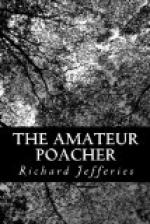Of this box Luke was as proud as if it had been the insignia of the Legion of Honour, and never lost an opportunity of showing it to every one of standing. When the village heard of this kindly present it ran over in its mind all that it knew about the stile, and the sacks, and the disused oven. Then the village very quietly shrugged its shoulders, and though it knew not the word irony, well understood what that term conveys.
At the foot of the hill on which the Upper Woods were situate there extended a level tract of meadows with some cornfields. Through these there flowed a large slow brook, often flooded in winter by the water rushing down from the higher lands. It was pleasant in the early year to walk now and then along the footpath that followed the brook, noting the gradual changes in the hedges.
When the first swallow of the spring wheels over the watery places the dry sedges of last year still stand as they grew. They are supported by the bushes beside the meadow ditch where it widens to join the brook, and the water it brings down from the furrows scarcely moves through the belt of willow lining the larger stream. As the soft west wind runs along the hedge it draws a sigh from the dead dry stalks and leaves that will no more feel the rising sap.
By the wet furrows the ground has still a brownish tint, for there the floods lingered and discoloured the grass. Near the ditch pointed flags are springing up, and the thick stems of the marsh marigold. From bunches of dark green leaves slender stalks arise and bear the golden petals of the marsh buttercups, the lesser celandine. If the wind blows cold and rainy they will close, and open again to the sunshine.
At the outside of the withies, where the earth is drier, stand tall horse-chestnut trees, aspen, and beech. The leaflets of the horse-chestnut are already opening; but on the ground, half-hidden under beech leaves not yet decayed, and sycamore leaves reduced to imperfect grey skeletons, there lies a chestnut shell. It is sodden, and has lost its original green—the prickles, too, have decayed and disappeared; yet at a touch it falls apart, and discloses two chestnuts, still of a rich, deep polished brown.
On the very bank of the brook there grows a beech whose bare boughs droop over, almost dipping in the water, where it comes with a swift rush from the narrow arches of a small bridge whose bricks are green with moss. The current is still slightly turbid, for the floods have not long subsided, and the soaked meadows and ploughed fields send their rills to swell the brook and stain it with sand and earth. On the surface float down twigs and small branches forced from the trees by the gales: sometimes an entangled mass of aquatic weeds—long, slender green filaments twisted and matted together—comes more slowly because heavy and deep in the water.




